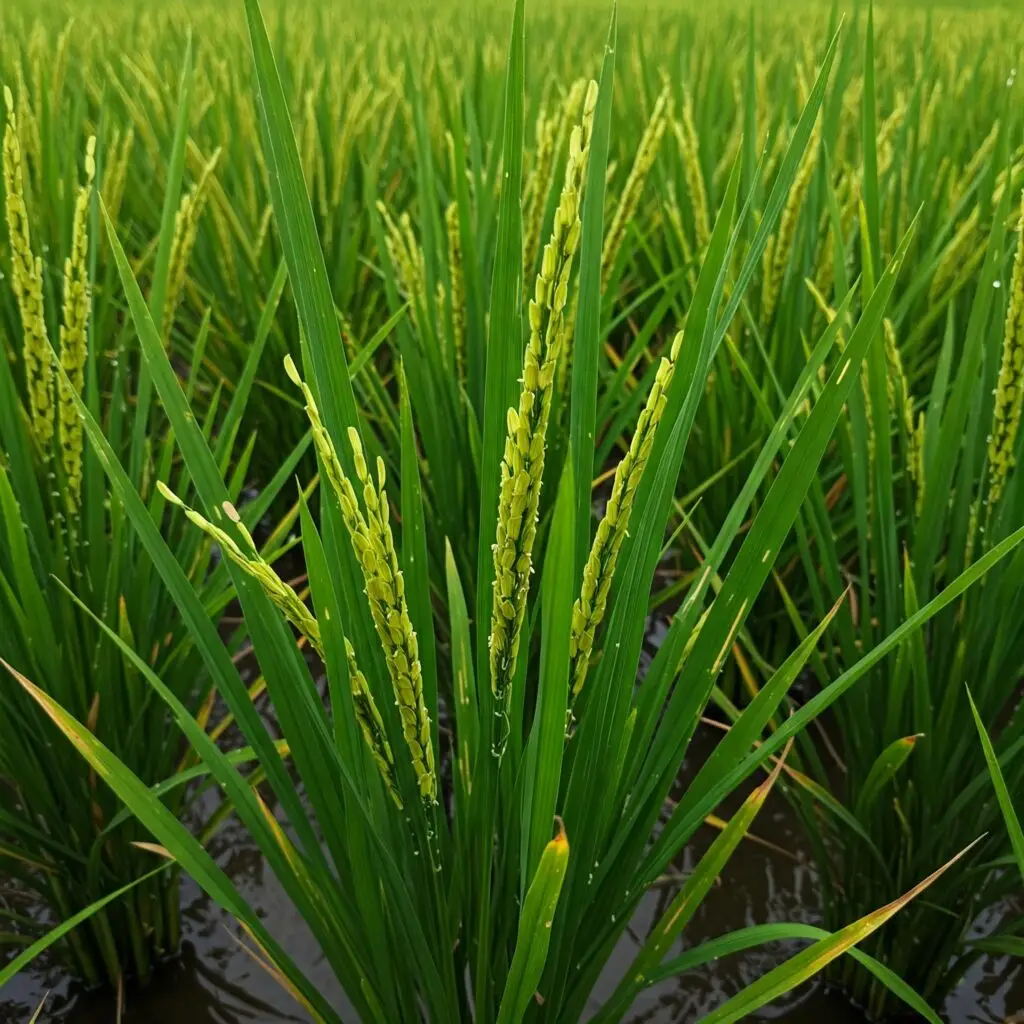Farmers in the Basmati rice growing areas of India (Delhi, Punjab, Haryana) facing challenges with weed control now have a promising solution: herbicide-tolerant Pusa Basmati rice. This article focuses on two key varieties, Pusa Basmati 1979 and Pusa Basmati 1985, developed by the Indian Agricultural Research Institute (IARI), and their potential to transform rice cultivation practices.

These varieties are not merely new rice strains; they are specially designed for contemporary farming techniques, providing a substantial benefit in weed management thanks to their tolerance to the herbicide Imazethapyr. Let’s explore the advantages and optimal practices for growing these groundbreaking rice varieties.
Pusa Basmati 1979: Enhanced Yield and Quality with Weed Resistance
Pusa Basmati 1979 (IET 28812) is a special Near-Isogenic Line (NIL) created through Marker Assisted Selection (MAS), and it’s based on the beloved Pusa Basmati 1121. What’s great about this line is that it keeps all the fantastic qualities of PB 1121, like its extra-long, slender grains (8.01 mm before cooking, 17.29 mm after cooking), wonderful aroma, and just the right amount of amylose content (21.68%).
What sets PB 1979 apart is its built-in tolerance to Imazethapyr herbicide. This feature allows farmers to effectively control weeds with a post-emergence application of Imazethapyr 10% SL, significantly reducing weed competition and leading to a potential yield of 18-24 quintals per acre under both direct-seeded and transplanted conditions. This tolerance also results in a possible reduction in cultivation costs by minimizing the need for multiple, expensive herbicide applications.
Key Features of Pusa Basmati 1979:
- Herbicide Tolerance: Complete resistance to Imazethapyr 10% SL.
- Grain Quality: Extra-long slender grains with excellent cooking quality and strong aroma.
- Yield Potential: 18-24 q/acre under both transplanted and Direct Seeded Rice (DSR) conditions.
- Maturity: 140-145 days after sowing (transplanted); 130-135 days (DSR).
- Suitable for: Basmati GI area (Delhi, Punjab, Haryana).
Pusa Basmati 1985: Early Maturity with Robust Weed Control
Pusa Basmati 1985 (IET 28814) is another herbicide-tolerant NIL derived from MAS, this time originating from Pusa Basmati 1509. It retains the superior cooking and grain quality of its parent, characterized by long slender grains (8.03 mm before cooking, 16.72 mm post-cooking), a strong aroma, and an intermediate amylose content of 21.89%.
PB 1985 features the benefit of early maturity, enabling timely harvesting and extending the opportunity for planting subsequent Rabi crops, especially wheat. This advantage may also help decrease environmental pollution linked to postponed field clearing. Like PB 1979, it boasts resistance to Imazethapyr, which aids in effective weed management while potentially yielding approximately 4.57 tonnes per hectare under dry direct-seeded conditions, performing comparably to its parent during standard transplanted conditions.
Key Features of Pusa Basmati 1985:
- Herbicide Tolerance: Complete resistance to Imazethapyr 10% SL.
- Grain Quality: Long slender grains with very good cooking quality and strong aroma.
- Yield Potential: Approximately 4.57 t/ha under dry DSR.
- Early Maturity: Facilitates timely harvest and subsequent cropping.
- Suitable for: Basmati GI area (Delhi, Punjab, Haryana).
Best Practices for Growing RobiNOweed (Imazethapyr Tolerant) Rice Varieties (PB 1979 & PB 1985):
To maximize the benefits of these herbicide-tolerant varieties, it is crucial to adhere to specific best practices for Direct Seeded Rice (DSR) cultivation, as these varieties are primarily recommended for DSR.
Do’s:
- Sowing Time: Undertake direct sowing in a well-prepared field from late May to mid-June (25th May to 15th June).
- Herbicide Application: Use the recommended dose of Imazethapyr 10% SL (from standard brands only) at 400 ml/acre for effective weed control.
- Spray Timing: Apply Imazethapyr 10% SL at the 2-3 leaf stage of weeds (approximately 18-22 days after sowing).
- Follow-up Spray (if needed): If weed pressure is high, a second spray of Imazethapyr 10% SL can be done within 15 days of the first application.
- Irrigation Before Spray: Irrigate the crop 2 days before spraying to ensure sufficient soil moisture for at least 3-4 days, followed by herbicide application when the field is walkable.
- Uniform Application: Ensure uniform spraying across the entire field.
Don’ts:
- Weed Stage: Avoid spraying Imazethapyr 10% SL if weeds have grown beyond the 2-3 leaf stage.
- Mixing Varieties: Do not mix/grow non-herbicide tolerant varieties in the same field.
- Windy Conditions: Avoid spraying during high wind speeds to prevent drift damage to neighboring non-HT rice crops.
- Tank Mixing: Avoid mixing other chemicals/fertilizers with Imazethapyr 10% SL.
- Flooded Fields: Do not spray in flooded fields; maintain only soil saturation.
- Water Bodies: Avoid using herbicides near water bodies.
- Irrigation After Spray: Do not irrigate the field for at least 7 days after spraying Imazethapyr 10% SL.
- Rain: Avoid spraying if heavy rain is expected within one hour after application.
Conclusion:
Pusa Basmati 1979 and Pusa Basmati 1985 represent significant advancements in rice cultivation. Their tolerance to Imazethapyr offers farmers a powerful tool for effective weed management, reduced costs, and potentially higher yields. By adopting these varieties and following the recommended best practices for DSR, farmers in the Basmati growing regions can look forward to a more sustainable and profitable future.
We at krishisuvidha.in are committed to providing you with the latest advancements in agricultural technology. Stay tuned for more updates and information to help you optimize your farming practices.




